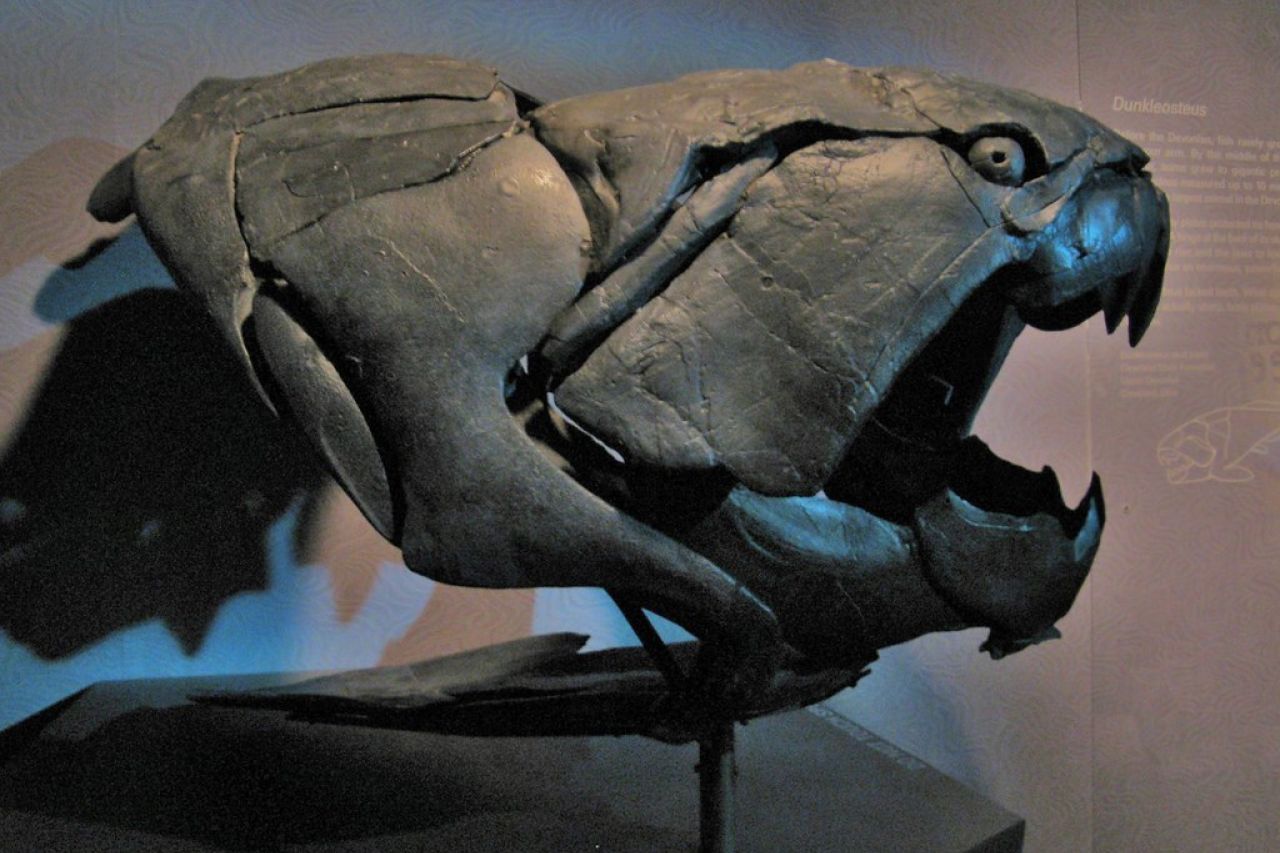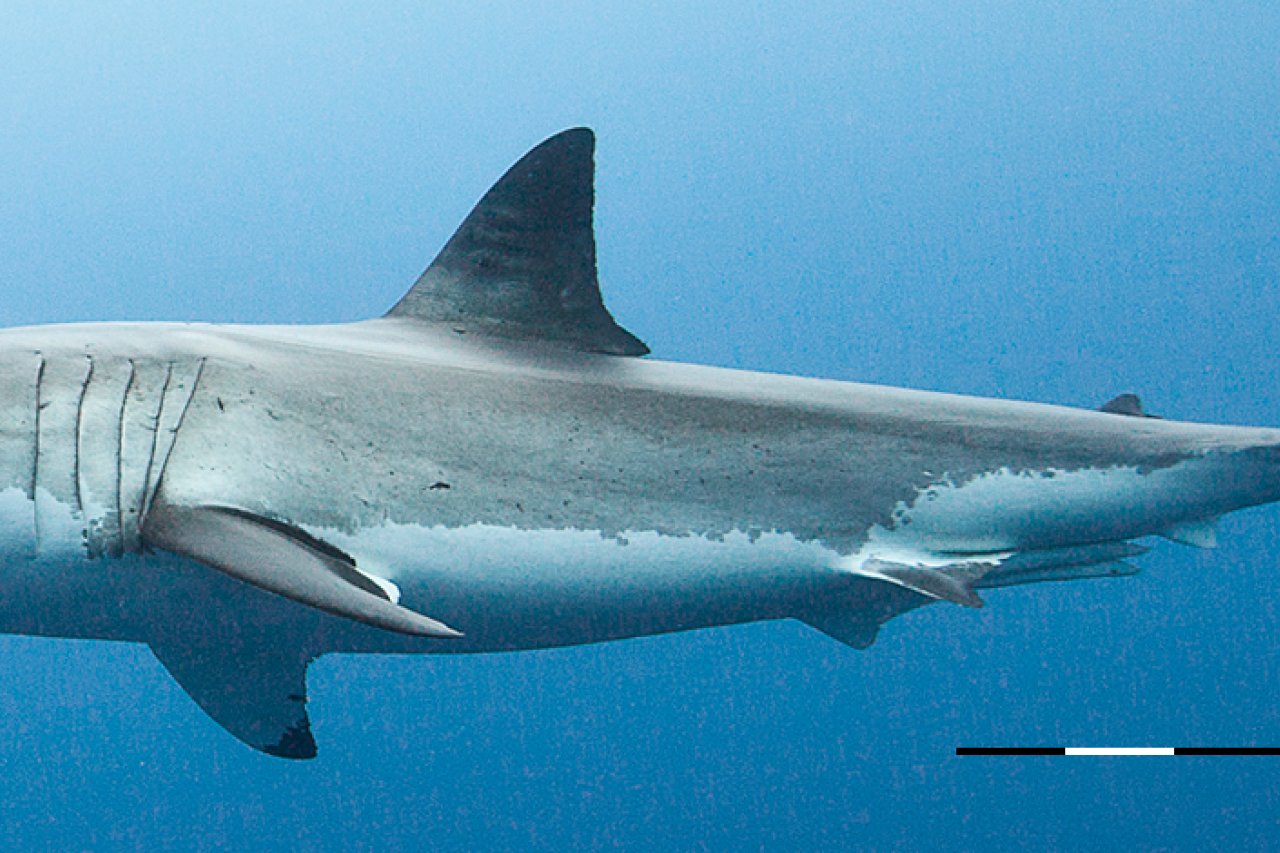Sharks are among Earth's most ancient creatures. First evolving over 455 million years ago, sharks are far more ancient than the first dinosaurs, insects, mammals or even trees. Sharks were there before the first animals left the oceans to walk on land, before our continents split up, and sharks were there when all five Mass Extinction Events almost wiped all life off the planet - but never sharks.
We love these living fossils - here are our top 10 prehistoric shark ancestors:
10. Scaleless shark (Cladoselache)
Cladoselache is regarded as the first "true shark". It lived 380 million years ago and it still retained a few characteristics of its fishy ancestors. It had a fish-like head, seven gills instead of five like most sharks, and its body was longer and less muscular than the sharks we see today. Its most obvious unique feature was that Cladoselache had no scales or denticle armour plates, just thin, fragile skin.

9. Spiny shark (Acanthodia)
The Acanthodia shark was a transitional species between sharks and bony fish (like tuna), and was in fact one of the first animals to have a jaw. Just like modern sharks, its skeleton was made of cartilage, but its fins were supported by bony spines like the ray-finned fish we see today.

The Acanthodia shark was a filter feeder, with rakes of cartilage in it gills to trap food particles. It rarely grew larger than 30cm, but during its time - 400 to 360 million years ago - this made it the largest filter-feeding animal alive.
8. Eel shark (Xenacanthus)
Xenacanthus was an ancient freshwater shark that died out 202 million years ago. This shark only grew to a metre in length and was far more similar to eels in appearance than modern sharks.

It had a long ribbon-like fin running along its entire back, and a sharp spine protruding from the back of its neck for protection. It is believed that this spine may have been venomous, similar to that of modern stingrays.
Xenacantus's thick V-shaped teeth was probably used to penetrate small prey, like crustaceans and armoured fishes.
7. Crusher shark (Ptychodus)
This shark roamed the world 100 to 85 million years ago, feeding on shellfish which it crushed with powerful jaws. These jaws were armed with over 550 massive flattened teeth, perfect for consuming the huge amounts of food this 11 metre-long behemoth would have needed.
Check out our black musselcrackers - they feed the same way the crusher shark did.

The massive Ptychodus was likely the largest shellfish-eating animal ever.

6. Ginsu shark (Cretoxyrhina)
Cretoxyrhina shared the oceans with ancient marine reptiles 100 to 75 million years ago, but it was still the ultimate predator. Plesiosaurs, tylosaurs, xiphactinus fish and even Archelon, the largest turtle ever, were all easy prey for the Ginsu shark – even though they were all larger than it.

It received its "Ginsu" nickname due to its 490 razor-sharp teeth, each growing 7cm long and having an unusually thick coating of enamel to keep them sharp. Growing up to 7m long, this was the largest shark alive (larger than the great white shark).
5. Greenland shark (S. microcephalus)
This shark is still alive today, but its incredibly long lifespan of over 400 years puts it far back into our history. The Greenland shark is the longest living species of any vertebrate.

The secret to this sharks success is its slow metabolism and lifestyle. It has never been seen swimming faster than 2.6km/h. In fact, it is so slow that experts aren’t even sure how it manages to catch seals, one of its main food sources, and current best guesses are that it ambushes them while they sleep. It is also a partial scavenger, and has been found to eat polar bear, reindeer and whale carcasses.
Luckily, the Greenland shark's slow metabolism means its flesh is deadly toxic to humans, and the ice cold water it lives in reduces its encounters with us even further.
4. Anvil shark (Stethacanthus)
The anvil shark was a small ratshark-like fish that lived 360 to 340 million years ago, most famous for its strange dorsal fin.

The top of this fin were flattened, resembling an anvil. On top of this structure was a toothy-brush comprised of enlarged denticles, the microscopic armour plates that cover modern sharks. This "anvil" has only been found on male Stethacanthans, leading scientists to believe it may have been used in their mating ritual.

3. Scissor-toothed Shark (Edestus)
The scissor-toothed shark lived 300 to 320 million years ago. The largest scissor-toothed shark, E. giganteus, would have grown to the size of a modern great white.

Its strangely curved jaws weren’t simply used for biting - Edestus would thrash its head up and down, creating slashing wounds on its prey. It is the only animal ever known to have used this hunting technique.

2. Mega-toothed shark (O. megalodon)
No "top 10 of sharks" list would be complete without the mighty Otodus megalodon, the largest shark that ever lived. Megalodon lived 23 to 2.6 million years ago, and its fossils have been found on every continent except Antarctica.

O. megalodon may have been the most proficient predator that ever lived, able to hunt the largest turtles, seals and whales. In fact, O. megalodon may have been the reason that modern whales, such as humpbacks, migrate into cold waters seasonally, as these are the only waters O. megalodon could not survive in. This adaptation of whales may have been what drove the colossal Megalodon to extinction, along with the evolution of a new alpha-predator: orcas.

Despite common belief, today's great white sharks are not descendants of the O. megalodon, and are in fact related to mako sharks. And yes, Meg is 100% definitely extinct.
1. Buzzsaw shark (Helicoprion)
Living from 290 to 250 million years ago, Helicoprion was lucky to have survived the Great Permian Extinction, the worst mass extinction event in Earth's history, where 90-95% of all living things died. Helicoprion is famous for its spiralled tooth-whorl, which palaeontologists once thought was the fossil of an ammonite - among many other weird hypotheses.

Modern predatory sharks are able to regrow lost teeth, if they didn't have this ability they would be much smaller and die at a younger age. Helicoprion was one of the first sharks to have this ability, making it one of the largest and most successful marine predators of all time.

Unlike modern sharks which shed old teeth to make space for new ones, Helicoprions' new teeth grew from the back of its jaw, constantly pushing its jawbone out in a massive underbite. The centre of this extended, curled up jawbone would actually be Helicoprions' baby-teeth from when it was a pup.
Pay a visit to these living fossils
Helicoprion is our favourite ancient shark, because it highlights all the things that make sharks great: their mystery, their adaptability and their diversity.
We have some sharks of our own, the real living fossils of the Two Oceans Aquarium. Spotted ragged-tooth sharks have been on Earth for over 28 million years. Our shysharks are members of an even older family of sharks, that has survived relatively unchanged for over 150 million years - outliving the dinosaurs and the fearsome Ginsu shark!
Want to see more ancient animals? You won't believe how sea turtles evolved...




